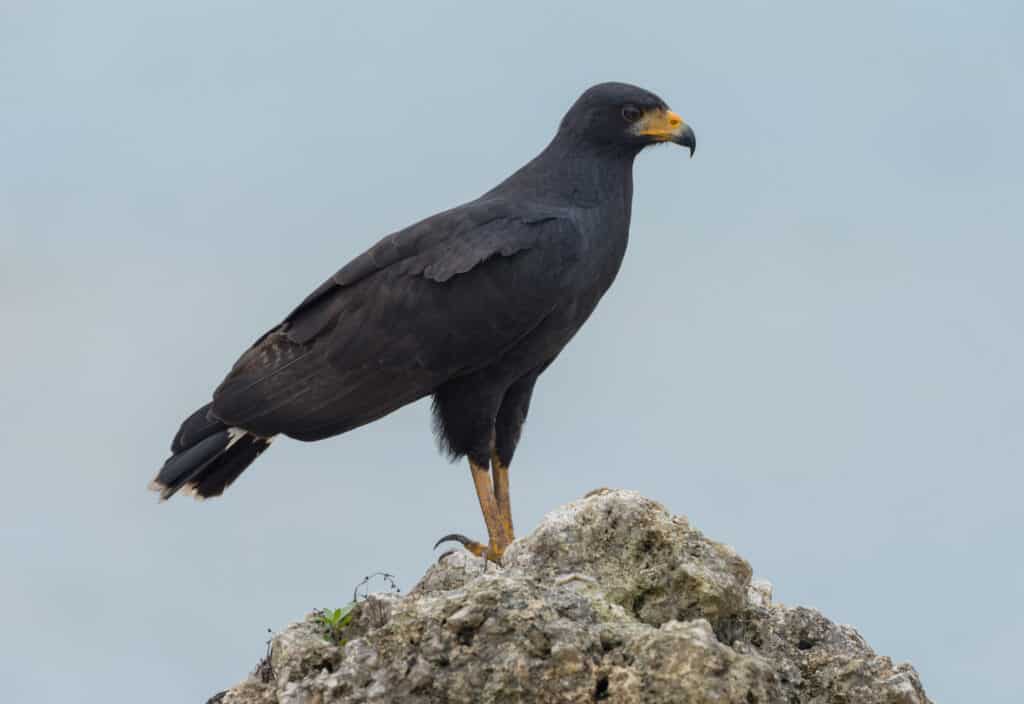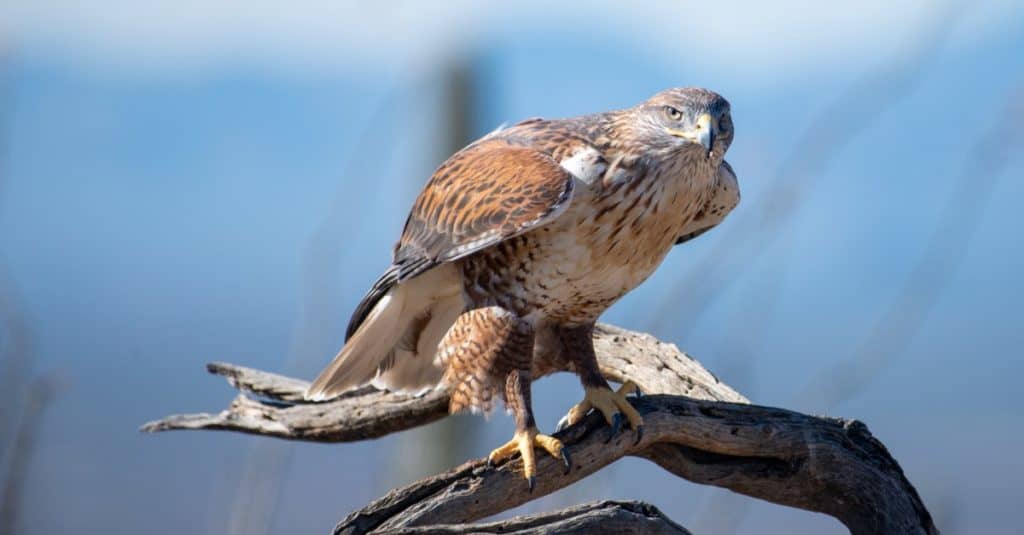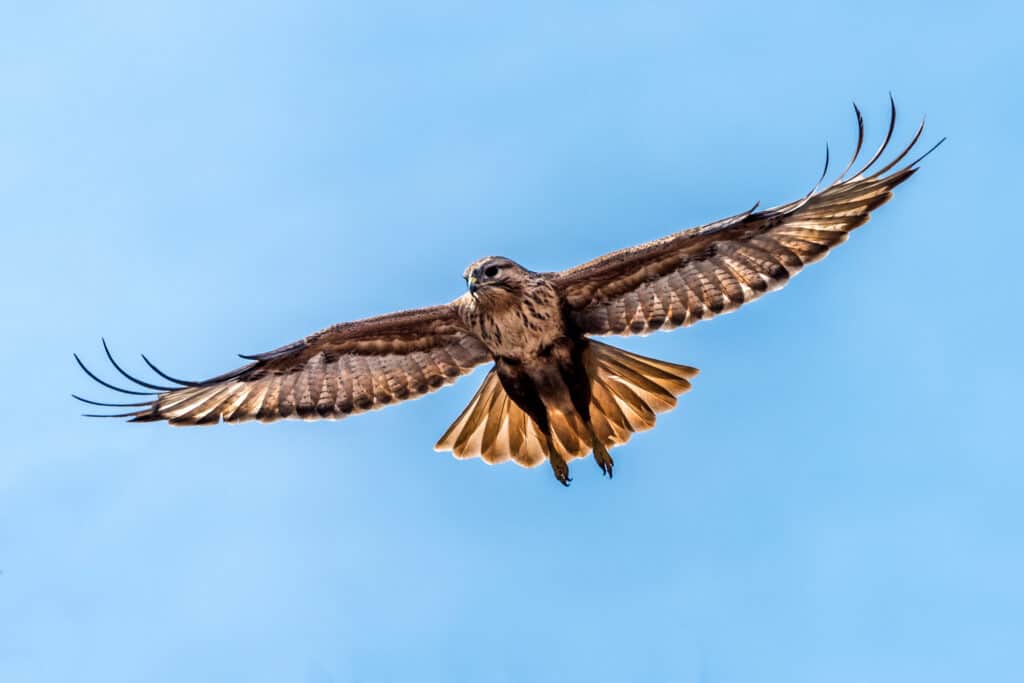Hawks are some of the most intimidating birds out there. They are well-known birds of prey, and many small animals have reason to fear them. Hawks are found on every continent except for Antarctica, meaning they are fairly ubiquitous overall.
However, some hawks are definitely bigger and more imposing than others. Though all hawks are fairly high on the food chain, there are some that would definitely be more of a threat than others out in the wild.
So which species of hawk is actually the largest? The answer might surprise you. Read on to discover the largest hawk in the world!
How Are Hawks Classified?

Hawks can be from two subfamilies within the Accipitridae family; true hawks are from the Accipitrinae subfamily, and buteo hawks are from the Buteoninae subfamily.
©iStock.com/Rainer Lesniewski
The classification of hawks can be somewhat confusing. For one thing, the word “hawk” is an umbrella term used to describe birds from two different subfamilies within the Accipitridae family. One is the subfamily Accipitrinae, and the other is the subfamily Buteoninae.
Birds of the Accipitrinae subfamily include sharp-shinned hawks, sparrowhawks, and goshawks, among others. Typically, these are woodland birds known for their high visual acuity. They sit on concealed perches while they look for prey.
Members of the Buteoninae subfamily, also known as the Buteo group, generally have shorter tails and bigger wings than members of the Accipitrinae subfamily. They also fly further distances when they are in open areas. They tend to descend from flight and pounce on prey.
Some call the accipitrine hawks “true hawks,” while they call the buteonine hawks “buzzards.” However, they are all birds of prey, and all of these birds share many similarities. They tend to eat smaller animals, such as fish, rabbits, mice, squirrels, lizards, and snakes. Accipitrine hawks, however, tend to primarily hunt other birds.
In addition to this, birds that are not taxonomically related to either of these groups are commonly referred to as hawks. Some people like to call peregrine falcons “duck hawks” and ospreys “fish hawks,” for example. However, peregrine falcons are part of the Falconidae family, and ospreys are part of the Pandionidae family.
The Largest Hawk in the World: Three Contenders
Which hawk is the largest in the world depends on how you look at it. There are actually three prime candidates for this title. Let’s take a look at them all!
1. Ferruginous Hawk

The ferruginous hawk is one of the two largest buteo hawks.
©Steve Bruckmann/Shutterstock.com
| Body Length | Wingspan | Weight |
| 20-27 inches | 48-60 inches | 2-4.5 |
The ferruginous hawk (Buteo regalis) is one of the two largest buteo hawks, making it a valid contender for the title of largest hawk in the world. It is the biggest and heaviest hawk in all of North America. Males are usually 20 to 26 inches long, with a 48- to 56-inch wingspan and an average weight of 2.4 pounds. Females are usually a little bit bigger, at 22 to 27 inches long, a wingspan of 53 to 60 inches, and a weight between 2 and 4.5 pounds.
These buteo hawks have big heads and short, hooked beaks, with large chests and long pointed wings. The adult birds have reddish coloring on their shoulders and back, as well as red legs. The wings are a grayish brown color on top and a lighter white or gray on the bottom. They have brown eyes, as well as pale heads with darkness on top and gray cheeks.
Typically, the ferruginous hawk inhabits open country areas in semi-arid grasslands. These areas often include open valleys, with scattered trees and mountains, so that they are able to fly overhead and scope out their prey. When they are migrating, you may see them in agricultural areas or around streams as well.
The vast majority of this bird’s diet, about 90%, is comprised of small mammals, including ground squirrels, prairie dogs, and jackrabbits. However, they also eat smaller birds. Typically, they hunt by flying swiftly at a low level over open ground and swooping down on their prey. However, there are situations where they fly high, scope out prey from perches, or hover.
2. Upland Buzzard

The Upland Buzzard (
Buteo hemilasius) is a migratory bird of prey that lives in Asia.
©iStock.com/Jason_YU
| Body Length | Wingspan | Weight |
| 26-28 inches | 56-63 inches | 2-4.5 pounds |
Some would say that the upland buzzard (Buteo hemilasius) is the largest buteo hawk that exists. In terms of certain measurements, such as length and wingspan, it is. However, in terms of bulk and weight, it’s about equal to the ferruginous hawk.
The upland buzzard has a typical body length of 26 to 28 inches, a wingspan of 56 to 63 inches, and a weight of 2 to 4.5 pounds. The upland buzzard and ferruginous hawk are about the same weight-wise.
There are two morphs of this bird: pale and dark. Pale upland buzzards are usually light brown and beige in color, with some white around their bodies and a yellowish head. Dark upland buzzards are mostly dark brown and black, with similar feather patterns to their pale counterparts but in much darker colors.
These birds can be found in many different habitats, such as open areas, grasslands, lowland agricultural fields, forest steppes, semi-arid deserts, and more.
Upland buzzards usually hunt by perching high in trees looking down at prey or hovering above them before swiftly swooping down to pick them up. These buzzards typically feed on small mammals, such as squirrels, pika, and voles. They also eat smaller birds, lizards, snakes, and several insects.
3. Northern Goshawk

The Northern Goshawk is the largest of the true hawks, although it is smaller than the two largest buteo hawks.
©iStock.com/Henk Bogaard
| Body Length | Wingspan | Weight |
| 20.9-25.2 inches | 40.5-46.1 inches | 1.4-3 pounds |
Although the Northern Goshawk (Accipiter gentilis) is not as big as the ferruginous hawk or the upland buzzard, it is the largest of the true hawks, as the other two are buteo hawks.
These hawks (both sexes) are typically between 20.9 and 25.2 inches long, weigh 1.4 to 3 pounds, and have a wingspan of 40.5 to 46.1 inches. As is the case with many hawks, females are larger than males.
The adult Northern Goshawk is a gray bird, with the top usually being darker than the underside. These birds usually have dark heads with white stripes over their eyes. Their eyes are usually orange or red.
Similar to other accipitrine species, Northern Goshawks sit on high perches looking for prey, and then they quickly attack. These birds usually live in coniferous forests, but they can make homes in deciduous hardwood forests as well.
The Largest Hawk in the World: The Verdict?
It can be a bit of a challenge to figure out which of the three aforementioned hawks is the largest. If you only want to consider true hawks, it’s definitely the Northern Goshawk. However, if you’re looking at all hawks, it might be more of a judgment call.
While the upland buzzard has the longest body length and wingspan, its average weight is about the same as the ferruginous hawk. So which is the largest hawk in the world? You decide!
Up Next:
- What Do Hawks Eat?
- Hawk vs. Eagle: 6 Key Differences Explained
- Falcon vs. Hawk: 8 Main Differences Explained
- Owl vs. Hawk: Which is Which, and Who Would Win in a Fight?
The photo featured at the top of this post is © Albert Beukhof/Shutterstock.com
Thank you for reading! Have some feedback for us? Contact the AZ Animals editorial team.






